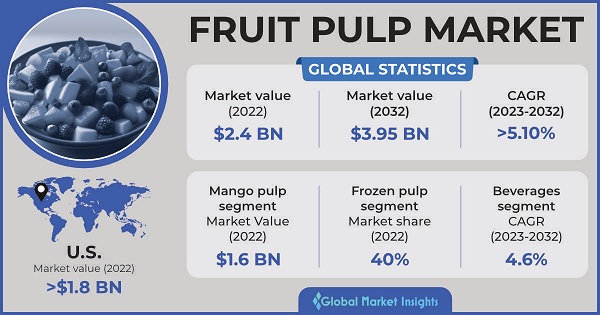Home > Food & Beverages > Food Additives > Flavor Enhancers > Fruit Pulp Market
Fruit Pulp Market Size
- Report ID: GMI6153
- Published Date: Jul 2023
- Report Format: PDF
Fruit pulp Market Size
Fruit Pulp Market size was valued at USD 2.4 billion in 2022 and is estimated to expand at 5.1% CAGR from 2023 to 2032. The market is closely linked to the food and beverage industry. With the continuous introduction of new products and flavors in the market, the demand for fruit pulp as a key ingredient for flavoring, coloring, and enhancing the sensory appeal of food and beverages is growing. Fruit pulp offers convenience as it can be readily used in various food and beverage applications without the need for peeling, cutting, or processing whole fruits. With changing lifestyles and busy schedules, consumers are increasingly opting for convenient food options, which drives the demand for fruit pulp.
Fruit pulp is known for its nutritional value, including vitamins, minerals, and fiber. As consumers become more health-conscious and seek natural and nutrient-rich food options, the demand for fruit pulp as a healthier ingredient in various products such as smoothies, juices, desserts, and yogurts increases.
| Report Attribute | Details |
|---|---|
| Base Year: | 2022 |
| Fruit Pulp Market Size in 2022: | USD 2.4 Billion |
| Forecast Period: | 2023 to 2032 |
| Forecast Period 2023 to 2032 CAGR: | 5.10% |
| 2032 Value Projection: | USD 3.95 Billion |
| Historical Data for: | 2018 to 2022 |
| No. of Pages: | 220 |
| Tables, Charts & Figures: | 250 |
| Segments covered: | Fruit Type, Form, Application, Distribution Channel |
| Growth Drivers: |
|
| Pitfalls & Challenges: |
|
The production and availability of fruits used for fruit pulp are often seasonal. This can lead to fluctuations in supply and prices, making it challenging to maintain a consistent and reliable supply of fruit pulp throughout the year. The fruit pulp market involves a complex supply chain that includes fruit growers, processors, distributors, and retailers. Coordinating and managing this supply chain can be challenging, particularly in terms of ensuring timely and efficient sourcing of fruits, processing, and distribution of fruit pulp.
The fruit pulp market is influenced by international trade dynamics, tariffs, import/export regulations, and currency fluctuations. Changes in trade policies and market volatility can affect the pricing, availability, and profitability of fruit pulp. Thus, the risks associated with fruit pulp may drive down the acceptance rate, further hampering the business growth.

